Early MMM Publication Nigeria 22.03.2024
Editor’s Note: Miss Murphy in this story is Lily Murphy, a long-time volunteer in Nigeria with MMM in the early days.
 Augustus sat outside his hut and stared at the rain, his whole form the picture of misery and dejection. A frog leaped close beside him and took refuge in the corner of the doorway, but Augustus paid no attention. His eyes were fixed in an unseeing stare, and he was thinking hard. He moved inside the doorway as the rain found passage through the mat roof over the balcony and came pouring down on him. It was typical wet-season rain, dancing off the path, for you know that in Nigeria the wet season means torrential rain for months at a time.
Augustus sat outside his hut and stared at the rain, his whole form the picture of misery and dejection. A frog leaped close beside him and took refuge in the corner of the doorway, but Augustus paid no attention. His eyes were fixed in an unseeing stare, and he was thinking hard. He moved inside the doorway as the rain found passage through the mat roof over the balcony and came pouring down on him. It was typical wet-season rain, dancing off the path, for you know that in Nigeria the wet season means torrential rain for months at a time.
But it wasn’t the rain that made Augustus feel sad. Oh, no, the tragedy was that he had lost Madam’s ducks. Madam, of course, is Miss Murphy, but all the schoolchildren love to call her “Ma-dam”. When Miss Murphy came back from her holiday last year the patients were so pleased to see her again that they presented her with a duck and a drake and eitght little ducks. Madam was delighted and said that when the little ducks got big, she would sell them in the market and buy scout uniforms with the money. The scouts were delighted when they head this, and Augustus was elected to look after the ducks, and he certainly looked after them very well until yesterday. Every evening at 5pm he would lock them up for the night, but yesterday evening he got so engrossed in watching the football match that he forgot all about the ducks. When he went to look for them this morning, they were gone. No wonder Augustus was so unhappy. What would Madam say? What would the scouts say when they heard that there would be no uniforms because there were no ducks?
Suddenly he moved. Rain or no rain, he must go out and search for the ducks. Everyone knew them as he had tied a piece of wire around the leg of each to distinguish them from the other ducks in the village. I wish I could tell you that Augustus put on his waterproof coat, rain hat and wellington boots before going out in the rain. But Augustus had none of these. He just broke off a large banana leaf from one of the banana trees and holding this over his head he ventured forth in search of the ducks. He went into every hut, but no one had seen Madam’s ducks. Suddenly he brightened up as he thought of the stream. Yes, they would surely be there. There had been no rain yesterday, just the burning heat of a tropical sun. Augustus usually left water for the ducks, but he had neglected that duty too. Probably the ducks had gone to the nearest stream which was almost a mile away.
Dropping his banana leaf, as the rain eased off, he hurried towards the stream, praying hard to the Virgin Mary that she would help him find the ducks. Soon his swift strides brought him in view of the stream and the sound of running water came to his ears. He lifted his head and stopped in his race as he saw advancing in line to meet him the familiar figures of Madam’s ducks.
Augustus exhaled an audible sigh of relief.
Yes, it was a wonderful day, thank God.
by Sr. Brigid Corrigan MMM England 20.03.2024
 Perhaps it was during the invaluable time I spent trundling along on the Yorkshire buses through England’s beautiful countryside as a child that the seeds of a missionary vocation were sown. Then I began to savour the stillness and serenity of the woods as I peered in from the roadside when the bus halted along the way. I wondered what mystery lay within. As we bounced along the country roads, I would let my mind wander to far away places. While the wonders of life were unfolding, I’d reflect on the people I had heard about in Africa and what we had to share with one another.
Perhaps it was during the invaluable time I spent trundling along on the Yorkshire buses through England’s beautiful countryside as a child that the seeds of a missionary vocation were sown. Then I began to savour the stillness and serenity of the woods as I peered in from the roadside when the bus halted along the way. I wondered what mystery lay within. As we bounced along the country roads, I would let my mind wander to far away places. While the wonders of life were unfolding, I’d reflect on the people I had heard about in Africa and what we had to share with one another.
That was a long time ago, but the memory of those peaceful moments on my journey remains with me. Travelling has become part of life for many of us. Often, we can be so caught up with getting to our destination that the golden moments along the way may be missed. All of us can recall the chance meetings – on trains, buses, boats, or planes, which turned out to be important in our lives, and blossomed into lasting friendships. We remember too, the times of being kept waiting, be it in land rovers in Africa, waiting for the rivers to go down, or in airports for the fog to clear. At first there was frustration because we had been slowed down, but gradually perhaps we recaptured the serenity and peace of our childhood as we discovered new joys in our waiting. St. Paul, the great traveller and missionary, had many an escapade on his journeys, none more than on the journey to Rome. While shipwrecked off Malta, he used each valuable moment (Acts 28: 7-10).
Our journeys too may be filled with surprises if we allow ourselves the time. Let us pray for one another as we continue our travels in life, that setting out in faith, we will keep going, full of hope. Above all, may we return to our homes when our work is done, full of thanks and love for those we met along the way.
First published by MMM in 1986
by Sr. Sheila Campbell MMM Ireland 18.03.2024
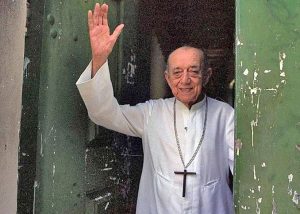 ‘When I give food to the poor, they call me a Saint’, mused Dom Hélder Câmara, ‘but when I ask why the poor have no food, they call me a Communist.’
‘When I give food to the poor, they call me a Saint’, mused Dom Hélder Câmara, ‘but when I ask why the poor have no food, they call me a Communist.’
This is the story of a great man who inspired me a lot when I first went to Brazil in the 1970s. He, like Mother Mary Martin, was small in stature, often looked frail but had a generous and courageous heart.
Born in 1909 in the city of Fortaleza in northeast Brazil, Hélder Câmara was the eleventh of thirteen children. Five of them had died in the terrible ‘flu epidemic which hit that region in 1905. From the beginning of his priesthood, (he was ordained a priest at a young age, 22), he devoted himself to social issues, including the reform of education. During his whole life, the struggle to defend the rights of the less privileged and marginalized, the forgotten and the excluded, shone like a beacon before him. His nickname was “bishop of the slums”.
He was influenced and encouraged greatly by Pope Paul VI, whom he first met in 1950. As soon as Dom Hélder was ordained bishop in 1952, he played a major role in the founding of the Conference of Bishops of Brazil and of CELAM, the Latin American Council of Episcopal Conferences. At the same time, he was deeply involved in the growth of the Brazilian Catholic Action, which played such an important role in the linking faith and the everyday problems of life during the time when the power of repression tightened upon the people. At the Latin American Episcopal Conferences in Medellin in 1968, and again at Puebla in 1979, his voice in favour of the world’s poor was heard. Dom Hélder has left 7,600 written meditations. More than 350 books have been published about him.
Now Dom Helder is on the road to canonisation and sainthood, but for many people, myself included, any formal process is unnecessary. He has touched our lives and taught us a valuable lesson:
“If I joyfully spend the rest of my life, of my powers, of my energies in demanding justice, but without hatred, without armed violence, through liberating moral pressure, through truth and love, it is because I am convinced that only love is constructive and strong.”
by Nadia Ramoutar MMM Communications Coordinator Ireland 16.03.2024
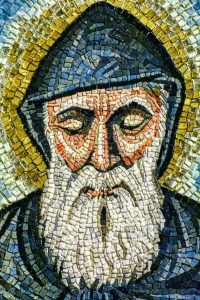 I lived part of my life away from Ireland and then I really dreaded St Patrick’s Day. The cheap green plastic beads, dyed beer, loud drunk groups wearing buttons or t-shirts with slogans like “kiss me I’m Irish” made me want to hide under the covers in bed. This was not the St Patrick’s day of my Irish Childhood nor was the behaviour befitting of the man behind the holiday, St Patrick.
I lived part of my life away from Ireland and then I really dreaded St Patrick’s Day. The cheap green plastic beads, dyed beer, loud drunk groups wearing buttons or t-shirts with slogans like “kiss me I’m Irish” made me want to hide under the covers in bed. This was not the St Patrick’s day of my Irish Childhood nor was the behaviour befitting of the man behind the holiday, St Patrick.
We know that turning a special holiday into a commercial day of profit is not new by any means, but I do feel that globally St Patrick’s Day is often ambushed by the worst of stereotypes about being Irish. So let us set the record straight. St Patrick is a man most worthy of being a Saint and being revered.
Perhaps the first point of interest about St Patrick, is that he was not Irish. As a young boy he was kidnapped and brought to Ireland as a slave. He was a young Roman living in Britain who was snatched and taken across the sea to Ireland. This was the first of many major challenges that St Patrick encountered in his life.
Let’s just say that 5th Century Ireland was no picnic. It was a challenging and conflicted place. There are myths and legends about St Patrick, but he was an admirable man who may not have been the first Christian in Ireland, nor was he even the first Bishop. He was, however, a man of courage and bravery who escaped slavery, went back to Britain and rather than accepting a life of prior privilege took a harder path returning to Ireland again to follow his faith.
Near the end of his life, St Patrick wrote two lengthy letters in Latin that survived which give us some insight not just into his life, but also into his heart. In these letters, St Patrick expressed his profound concern for the women of Ireland, many were enslaved and faced brutality and abuse on an on-going basis.
So many obstacles were in St Patrick path, but he didn’t turn his back on challenges or injustice. He was determined to face danger and to make Ireland a better place. He went from being a scared boy on a hill in a foreign country with only sheep for company, to being a shepherd of people guiding and protecting them. St Patrick was not a meek and mild saint, but stood up for what he believed and admitted to his own flaws and failings.
When I was in Tanzania, Africa recently, my colleague Sr. Sheila and I became fascinated by the young boys we saw herding sheep and other cattle on the side of major roads. It was so different from how children in our Western culture are raised. As we saw them busy in their role or occasionally sleeping under a tree letting the animals wander, I thought, “who knows, that boy might grow up to be a Saint like Patrick.”
by Sr. Aileen Doggett MMM Ireland 14.03.2024
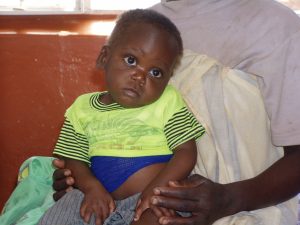
I want to tell you about a wonderful experience I had during my time in Nigeria. It happened one morning as my two Nigerian co-workers and I were passing through a village to go to the next one for a meeting with the Chief and his people who were all assembled in their village square. They were waiting for us to come and teach them how to make the sugar/salt/water mixture for the treatment of dehydration caused by diarrhoea which can be very prevalent among young children in the area where we were working. It is a known fact that 5000 children die from dehydration every 15 minutes! This simple sugar/salt/water mixture (called ORT – oral rehydration therapy) prevents dehydration and saves many lives.
As we were moving through the village in our little car, a woman carrying a child in her arms came running out to stop us. As I looked at the child, I was shocked at his condition. He was gasping and so limp in his mother’s arms. Even as we were talking to the mother, the child was violently sick. I prayed, “Lord, don’t let this child die. What should we do.” I put the mother and the child into the back of the car, complete with empty beer bottle, this being the correct measure of water for making ORT, and we drove to the next village.
The people were all sitting around with the Chief. I asked them to pray that God would bless our meeting and in my own heart I prayed that this child would not die. The people might blame me. Then I took the child from the mother and walked among the people asking them what they thought of this child. Most said he is dead or dying. Others said that his eyes had fallen into his head, his skin looks like paper it is so dry. I then asked them “Why?” They replied – because of diarrhoea. I said, “Why is he sick?”. They gave me all the causes and how to prevent it. I said alright this child is weak now because it is losing so much fluid. We have to replace it.
I asked Magdalen, one of my co-workers, to show the people how to make the ORT solution. As soon as she had some made, I took the child again from the mother and tried to spoon feed it. It took it slowly and reluctantly at first. As I whispered another prayer, and then, as soon as I saw the child sipping from the spoon, I poured some into the plastic cup which the people brought and behold, the child began to drink. I cannot tell you how relieved I was! I gave the mother the solution and she carried on feeding the child while we continued with the demonstration. First the adults, and then the children.
The children learned very well and they enjoyed making up the solution and went back to their places singing and clapping. Theis took about 60-90 minutes. During this time, I would take a quick look sideways at my little sick friend to see him drinking plenty now from the cup the mother was giving him. What a wonderful surprise I got when the children were singing and clapping. Then the people all said “Sister, he is alive!”. Then he turned to me with his two big eyes looking straight at me and gave a big smile! The people said, “Sister, do you see how this child is thanking you.” This child’s smile of thanks will always remain with me and is enough to make all my little efforts worthwhile.
The mother came and made some solution herself. She did it perfectly, poured it in to the empty beer bottle and went off trekking back to her village two kms. Away with her child tied to her back, her bottle of ORT and she was dancing and singing.
First published by MMM in 1988
by Sr. Sheila Campbell MMM Ireland 12.03.2024
 Language can be funny. At the same time as it can be used to explain things, often our interpretations trip us up. Many years ago, I was traveling in the USA with one of our Irish Sisters. I was doing the driving, and she was looking at the scenery as we sped along the highways. “Well,” she said, “These Americans certainly do look after their bodies. Look at the number of places that sell cosmetics!”. I looked sideways to see what had attracted her attention. It was a commercial unit with the placard “Body Shop”. I had to explain to her that in America, a Body Shop was an auto repair garage.
Language can be funny. At the same time as it can be used to explain things, often our interpretations trip us up. Many years ago, I was traveling in the USA with one of our Irish Sisters. I was doing the driving, and she was looking at the scenery as we sped along the highways. “Well,” she said, “These Americans certainly do look after their bodies. Look at the number of places that sell cosmetics!”. I looked sideways to see what had attracted her attention. It was a commercial unit with the placard “Body Shop”. I had to explain to her that in America, a Body Shop was an auto repair garage.
This story from Nigeria is about yet another kind of auto repair outfit. I hesitate to call it a garage. Sr. Ann was travelling from Abakaliki to Ogoja. In those days it was a three-hour journey on very bad roads. She set out with Sr. Cecily who was going on temporary relief and who decided to do the driving there so that Sr. Ann could do the drive back the next day somewhat rested. Sr. Ann was nervous about the journey as she didn’t like driving much. She told Sr. Cecily this, and her hesitation about returning alone on such a bad road. It was quite a deserted stretch of road, and what if anything happened? “Don’t worry, dear”, said Cecily in the best style of Mother Mary Martin, “All will go well.”
It began badly the next morning when she went out to the car – a flat tyre. “No big problem”, she was told. Lucky Boy would fix it. The spare wheel was put on the car and Ann and Cecily set off to Lucky Boy’s auto repairs. Lucky Boy was found squatting at the side of the road, under the shade of a tree. His workshop consisted of a tractor tyre cut in half. One half held water, and the other half some elementary bits of tools and a bottle of lemonade. The tyre tube was examined. “No good, Sister, you need to buy a new tyre.” How much will it cost? After enquiries Sr. Ann realised it was going to cost four times the usual price. No, that would not do. Was there not any other solution?
Out from the back of his hair, Lucky Boy produces a sewing needle. In his “toolbox” was some black thread. He proceeded to mend the hole, like darning the heel of a sock, back and forward with herring bone stitches. Once the hole was held together, he placed a piece of rubber from an old tyre on top of the whole and put the whole thing into a small machine called a vulcanizer. This process makes the rubber hard. Like a miracle, when the tube was inflated the hole had been repaired.
Now all was set for the journey home to Abakaliki, with the repaired wheel back on the car and the spare back in its place. But Lucky Boy had one more piece of advice. “Sister, take this lemonade. You are nearly fainting! You need it for the journey!”
By Nadia Ramoutar MMM Communications Coordinator Ireland 10.03.2024
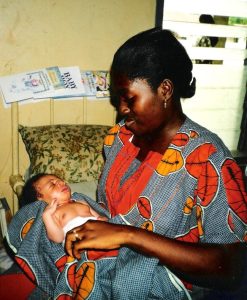 In the Western world, the weeks before Mother’s Day we see an abundance of chocolates, pyjamas, mugs, plants and other gifts being promoted in shops reminding people to buy their mother a gift. We have gotten to a place where the concept of Mother’s Day has probably lost its dignity going the way of Valentine’s day with obligated purchases. Mother’s Day is not even globally consistent as some parts of the world unlike Ireland, celebrate Mother’s Day in the second Sunday in May.
In the Western world, the weeks before Mother’s Day we see an abundance of chocolates, pyjamas, mugs, plants and other gifts being promoted in shops reminding people to buy their mother a gift. We have gotten to a place where the concept of Mother’s Day has probably lost its dignity going the way of Valentine’s day with obligated purchases. Mother’s Day is not even globally consistent as some parts of the world unlike Ireland, celebrate Mother’s Day in the second Sunday in May.
We just can’t seem to agree over Motherhood in many ways. As my work with the MMMs brings me in contact with global health issues for women, the horrifying conditions many girls and women face in childbirth is heart breaking. Before working in Communications for the MMM Sisters, I did not know about the thousands of women face daily when they are pregnant and find themselves in a deadly birth situation for them, their child or both. I recall reading my first report on Obstetric fistula and just weeping. It’s not entirely my fault I did not know about this as Obstetric Fistula stopped being an issue here about 100 years ago. It’s been a deadly secret.
We have not had to deal with the death, rupture or wounds caused in childbirth for so long but possibly up to half a million women in Sub-Saharan Africa and Asia are dealing with it now. Along with high rates of maternal or baby death, those who live with Obstetric Fistula are also subjected to tremendous pain, discomfort, social and emotional abuse and severe mental health issues. Torn vaginal walls from birth complications or obstructions lead to uncontrollable leakage of urine, faeces or both. This causes the women to be ostracized, abandoned or abused due to the horrendous smell they cannot control.
It is a cruel twist of fate that a woman’s geography can become her destiny. As a humanitarian, I cannot accept this. The MMMs have been pioneers in working to prevent and repair Obstetric Fistula for decades and today actively work to heal girls and women impacted. There are a lot of grey areas in addressing this issue as even statistics on how many women are suffering with it now do not agree. It is grossly underreported. It is said that the waiting list for repair is so long, it would take over 80 years to catch with the current demand. It could also be easily ended or prevented with basic anti-natal care access for all.
More than just being a medical issues, this is a human rights issue. We are working with Toni Pyke, AMRI and Fr Edward Flynn, Spiritan to see how we can get safe childbirth to be acknowledged as a human right, because currently it is not. We seek to coordinate the efforts on Obstetric Fistula making it “history” for Sub-Saharan Africa and not just for girls and women in the Global West. We are raising awareness so resources can be gathered to rewrite the stories of all women, not just the privileged ones.
International Women’s Day
by Nadia Ramoutar MMM Communications Coordinator Ireland 08.03.2024
 Being a woman in our modern world is not easy, but talking about why it is challenging can also be – well, challenging.
Being a woman in our modern world is not easy, but talking about why it is challenging can also be – well, challenging.
In the middle of the night last night my son woke me up vomiting. I am a working single mother and such a sound was like a nightmare. The next blurry hours were a challenge I somehow staggered through but managed to make work. Such a challenge is minor compared to the difficulties other women faced last night. Some were in a warzone or a refugee camp, a domestic violence situation or living on the streets. I am fortunate to have a place to live and running water to wash clothes and electricity to keep my son warm and safe. Like many women I work hard to overcome challenges daily and balance it with the guilt of my complex feelings.
International Women’s Day (IWD) is often misunderstood and used as a marketing ploy with is denigrating. It began by a large group of working class women who were protesting for safer working conditions, better pay and basic rights like voting that at the time they were denied globally. The women back on the first IWD created in 1911 sought to seek equality for women. I wonder if they could see the condition of women in the world would they feel we have come far enough? What more can we do?
The statistics for women in the world now reflects things like 70% of the poor are women when women make up 51% of the population, many of those poor are abandoned with children. At least one in four women will experience sexual violence in her lifetime. In reality there have also been many ways in which women have been empowered and women empower one another, but the trend is still uninspiring.
When I look at the pioneering work of the MMM women I am truly inspired to continue to strive for all mothers with sick children or women facing poverty, violence and hunger. I am motivated far beyond my own conditions to work for the best for all women, those with children and those without, those with jobs and those working at home. My appreciation for all women’s resilience grows as I have compassion for the limitations we all face globally, but still carry on.
For 2024, the IWD the theme is ‘let’s Inspire Inclusion’. The messaging is that ‘when we inspire others to understand and value women’s inclusion, we forge a better world. And when women themselves are inspired to be included, there’s a sense of belonging, relevance and empowerment. The aim of the IWD 2024 #InspireInclusion campaign is to collectively forge a more inclusive world for women.’
My wish for the world is that we honour all the women who went before for pioneering the way for us, and we work together for women in the future that they may be more free and experience more equity than we do today.
by Jo Doyle Ireland 06.03.2024
 Woosh.
Woosh.
Like a black meteorite flashing past the window frame. A quick glance up from the dinner table, where three of us sit wondering what we had just seen. The screech was loud and long, but there was nothing there. We were used to noise in our garden. It was a colourful menagerie of sound. Small yellow tits teeming with expectation. Starlings greased up for a day of titillation. Sonorous blackbirds in pursuit of some titbits of bread or feed or nuts. The fashionable cock pheasant strutting his wares, cocky in his magnificent colours. The poor man’s peacock of the elegant countryside followed meekly by his harem of beige women, alert women, feeding on the grains left for the chicken in the grass, ready to run, the most amusing of runs, at the least sign of trouble.
This is our garden. A fashion show of colour and song, of elegance and wit. Our yellow hedge filled with the yellow birds. The single Robin, opening its tiny beak, puffing out its red breast to voice the loudest of songs. Oh, I could watch that Robin all day long, and could listen to the message of hope that it sings.
“Joy. Joy to the world!!!”
Then the unfamiliar noise happened. A black cloud descends and the cacophony of fear and fight and help and rescue of a thousand crows descend. Oh, this fashion fair has become deafening. What, oh what has just happened?
We three stand up from our dinner table to look out our window. The familiar green grass is black with noise and fear. A second, maybe two, is needed to focus on what is happening. The yellow tits are screaming. The Robin runs away as do the beautiful blackbirds.
And then, we see.
And then we understand.
It’s a murder.
A killing.
George Floyd comes into my mind.
The policeman’s knee with full weight pressing down on his back. Uninviting the air from his lungs.
Death and murder.
Such a showing.
Such a noise.
This noise is deafening.
The large hawk. The jet speed attack.
Faster than aerial lightning.
Vroom.
Stunning the crow. The full weight, pinning him down. The steel rigid claw clamping the crow’s beak tight shut.
Suffocation.
Murder murder, murder the crows craw, murder!
The speed, the brutality, the weight of the hawk on the crow’s chest suffocating it.
My thoughts.
Lord, I don’t like crows.
Lord, George Floyd, breathe let me breathe.
The clawed clamp on the beak. This is nature. This is what happens.
Sinead, lover of animals, animal whisperer, has gone unnoticed from our kitchen. We see her slipping her foot between the legs of the hawk and she hops and lifts her leg up slowly once, twice.
The noise is terrific. The crows are screaming free him, help him, release him, and as Hawk loses his grip on the beak the crows ascend in a black cloud, the victim still alive, camouflaged by the others.
The Hawk has gone.
The birds salute in a speedy circle.
The excitement disappears.
And the Robin sings glory Hallelujah once again.
Jo Wardhaugh Doyle is farming in Kildare with her husband Matt. She has worked in Uganda, Ethiopia and Kenya, but more recently has worked with Sr Rita Kelly MMM doing the REAP programme in the Irish Missionary Union (IMU).
by Sr. Siobhan O’Keefe SHMJ Ireland 04.03.2024
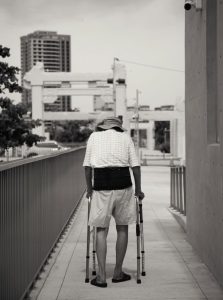 My lasting memory of ‘Joe’ was as he stood before the food cupboard of an Evangelisation and Outreach Centre in a major city one Thursday afternoon. As well as basic provisions, he was choosing little treats that he would enjoy over the coming days. It was not to be. On Sunday morning I received a phone call to let me know that this frail gentleman who attended the centre several times a week had been found dead at home on Friday morning. The sense of shock that all who knew ‘Joe’ experienced was profound…frail, elderly people living and dying alone in the U.K in 2023 is a tragedy of our times.
My lasting memory of ‘Joe’ was as he stood before the food cupboard of an Evangelisation and Outreach Centre in a major city one Thursday afternoon. As well as basic provisions, he was choosing little treats that he would enjoy over the coming days. It was not to be. On Sunday morning I received a phone call to let me know that this frail gentleman who attended the centre several times a week had been found dead at home on Friday morning. The sense of shock that all who knew ‘Joe’ experienced was profound…frail, elderly people living and dying alone in the U.K in 2023 is a tragedy of our times.
At his crematorium memorial service on Monday of Holy Week the registrar quoted the poem, ‘The Dash’ by Linda Ellis.
This speaks of the time between one’s birth and one’s death…how do we spend these precious years, ‘For it matters not, how much we own, the cars, the house, the cash, what matters is how we live and love, and how we spend our dash.’ In the silence, I reflected on how I spend my life and thought of how Jesus spent his dash….. a life to of total self-gift to others.
Like Jesus, Joe had suffered greatly but it did not thwart his desire to reach out in love to others.
Sadly, not unlike ‘Joe,’ Jesus had died alone. He had been abandoned by some of his closest friends, betrayed by a beloved disciple and left to hang in shame on a wooden cross. His offering was total self-gift so that each one of us could come to fullness of life in Him.
May we live our dash in gratitude to him and spend our lives in loving service of the most vulnerable in our world.
